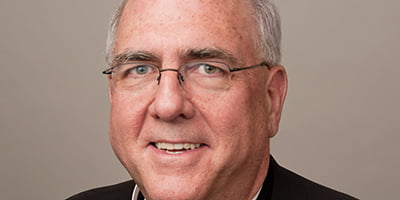by Archbishop Joseph F. Naumann
This week, I complete the trilogy on my pilgrimage with our seminarians to Santa Fe, New Mexico.
One of the impressive features of Santa Fe is the town square. In the heart of Santa Fe is its beautiful cathedral, the oldest government building in the United States, several art studios, shops, restaurants, and green space.
A couple of the days, we visited different significant religious sites near the Santa Fe Plaza. Our seminarians, who are currently in theology, wear clergy shirts and those in the college program wear a shirt that has the crest for the Archdiocese of Kansas City in Kansas. I suppose that so many young men dressed in black made an impression on the locals.
The last day in Santa Fe, a woman stopped a couple of our men asking them if they were part of the group from Kansas City, Kansas. She informed them that she had lived most of her life in the Archdiocese of Kansas City in Kansas. About 10 years ago, she had moved to Santa Fe to enjoy the beautiful climate. She wanted our men to know how much she loved and admired many of our archdiocesan priests. She was excited to share with them what a profound impact the ministry of our Kansas City, Kansas, priests had made upon her life.
Our men were deeply touched and encouraged by this woman’s affection and gratitude for the priests of our archdiocese. They were impressed by how important it was for this woman to make them aware of what a remarkable group of men they were preparing to join.
We also visited Taos Pueblos, the oldest continuously inhabited community in the United States. We had the opportunity to hike the Bandelier National Park as well as what is popularly called the Tent Rocks National Monument. We visited some amazing places and celebrated Mass in some of our nation’s most historic churches.
The number one highlight for me of the pilgrimage was our visit to the Chimayo Shrine. Chimayo is a place of great devotion for many people in the Southwest. Similar to the curative power associated with Lourdes water, at Chimayo there is healing power associated with what is popularly referred to as the “holy dirt.” There are many remarkable miracles attributed to the prayers offered at this sacred site.
However, what made our visit to Chimayo so powerful for me was not its remarkable history nor the many healings, but our guide. She described herself as a dedicated pilgrim. At first, I was not certain what she meant by that title.
This woman had a successful career as a nuclear engineer. Several years ago, she decided to leave her profession, dispose of her material possessions, and live a life completely dependent on divine providence.
I thought taking a bus from Kansas City to Santa Fe was a fairly arduous journey, until our guide informed us that on one of her pilgrimages she walked from St. Louis to Santa Fe. She made another pilgrimage that began in Buenos Aires, Argentina, and concluded at the Basilica of Our Lady of Guadalupe in Mexico City. Her most remarkable pilgrimage began on the west coast of North Africa and ended in Jerusalem. She had walked across the entire breadth of North Africa through areas of civil war and intense conflict.
Her purpose for all these pilgrimages was to share the joy of the Gospel with all those she encountered. What was most striking about her was her joy. She had forsaken everything our secular world considers important and abandoned herself completely to depending on God’s providence.
The joy of this very gifted woman, who had left everything to follow Jesus more completely with her life, was very affirming for our seminarians, who are also being called to abandon everything to follow Our Lord. Our guide demonstrated what is possible for one who possesses nothing materially and yet has discovered the one thing necessary for authentic and enduring joy — Jesus Christ.
Finally, for the vast majority of the pilgrimage we had the same bus driver, a young man perhaps in his early 30s. At the very end of his time with us, when we were nearing the place where he would hand us over to another driver for the last leg of our return journey to Kansas City, he shared with us that he had been deeply moved by his time with us. He had been raised a Baptist. In his driving career, he had transported many different religious groups — Jews as well as a variety of Protestant denominations.
With emotion, he told us that this trip had been special for him. After being exposed to our communal prayer and listening to the sharing of our seminarians about their faith experiences, he felt moved to renew his own faith life. He called the experience of sharing this time with us as life-changing.
After spending the better part of a week with our seminarians, I can say to you truly that the future of the Catholic Church in northeast Kansas is bright, because of the quality of the men who will one day be serving our Archdiocese as priests. They will continue the long and storied tradition of dedication and zeal that has characterized for more than a century and a half the priests of northeast Kansas. The future looks bright!
I promise this is my last column on what I did for my summer vacation!



